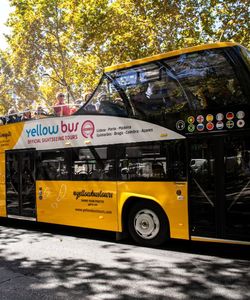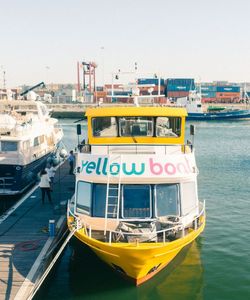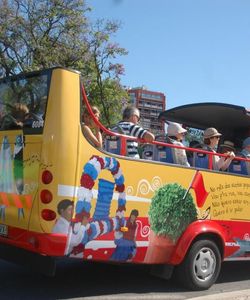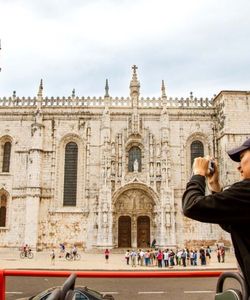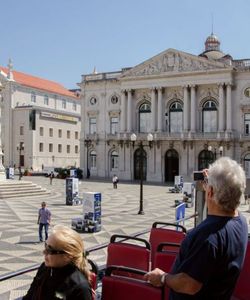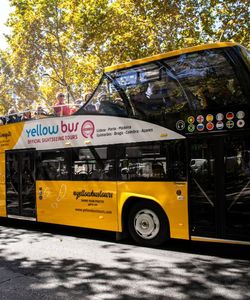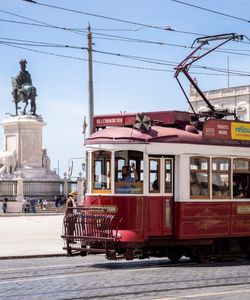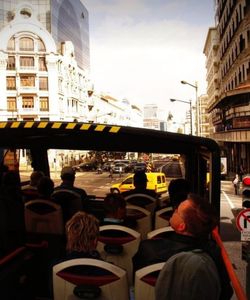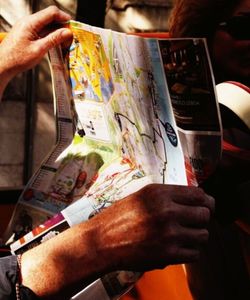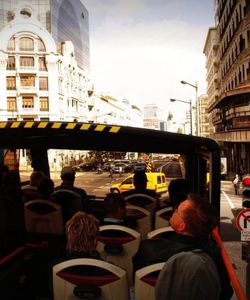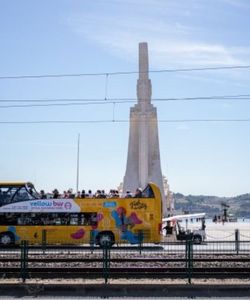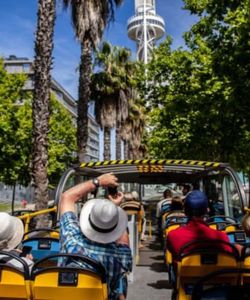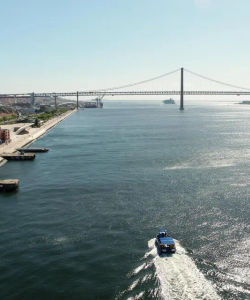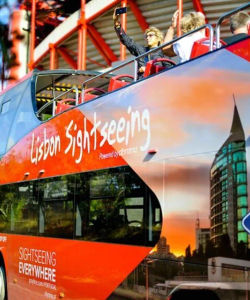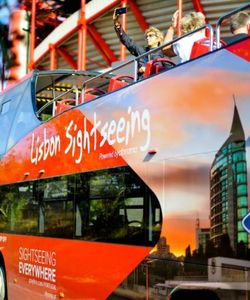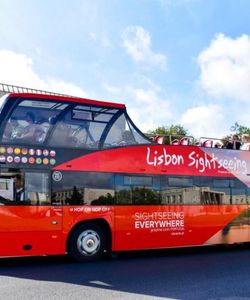Lisbon Hop On Hop Off Bus Tours
Yellow Bus: Lisbon Hop-On, Hop-Off Open-Top Bus Tour
- Unlimited Lisbon Hop on Hop off across the chosen route
- Access to National Monument Lisbon Funiculars and Santa Justa Lift for free
- Free access to public trams
- Access to Discounts on restaurants, museums, monuments and more!
- Smartphone Voucher Accepted! (No need to print)
- 24H or 48H - Unlimited Lisbon Hop On Hop Off Bus (as per the option chosen)
- Choice of Bus lines - Belem, Modern or Both !
- Audio Guide: Portuguese, English, Korean, French, Spanish, German, Italian, Dutch, Japanese, Russian, Portuguese in Brasil, Swedish, Mandarin
- Exclusive discounts on restaurants, museums, monuments and more!
- FREE access to Santa Justa Lift and viewpoint
- FREE access to Bica, Gloria and Lavra funiculars and to Carris public trams
- 24H or 48H - Unlimited Lisbon Hop On Hop Off Bus (as per the option chosen)
- Choice of Bus lines - Belem, Modern or Both !
- Audio Guide: Portuguese, English, Korean, French, Spanish, German, Italian, Dutch, Japanese, Russian, Portuguese in Brasil, Swedish, Mandarin
- Exclusive discounts on restaurants, museums, monuments and more!
- FREE access to Santa Justa Lift and viewpoint
- FREE access to Bica, Gloria and Lavra funiculars and to Carris public trams
All buses have a ramp and a dedicated place for 1 wheelchair per bus.
Stroller accessible
Near public transportation
Infants must sit on laps
Hop on Hop off: hop on and off on any stop along the route, while your ticket is valid.
CARRISTUR reserves the right to change, suspend or eliminate any of its touristic products or transport services.
CARRISTUR shall not be held responsible for tickets loss or theft.
Find us at the at the Praça do Comércio Yellow Bus Kiosk (9.00am-6.00pm) or contact Yellow Bus Customer Service- (+351) 218 503 225 (9.00am-1.00pm) | yellowbus@carris.pt
Click here for Live Bus Tracking
Disclaimer: Due to traffic issues, public holidays, weather conditions, cruise ship arrivals and unforeseen circumstances, there might be sudden changes in the route or on the schedule. In "normal times" Lisbon is a busy city, especially during special events, summer holidays and at weekends. Traffic congestion and road closures - may cause delays, reduced frequency and changes to the route. We’ll do all we can to provide a smooth and frequent service!
All buses have a ramp and a dedicated place for 1 wheelchair per bus.
Stroller accessible
Near public transportation
Infants must sit on laps
Hop on Hop off: hop on and off on any stop along the route, while your ticket is valid.
CARRISTUR reserves the right to change, suspend or eliminate any of its touristic products or transport services.
CARRISTUR shall not be held responsible for tickets loss or theft.
Find us at the at the Praça do Comércio Yellow Bus Kiosk (9.00am-6.00pm) or contact Yellow Bus Customer Service- (+351) 218 503 225 (9.00am-1.00pm) | yellowbus@carris.pt
Click here for Live Bus Tracking
Disclaimer: Due to traffic issues, public holidays, weather conditions, cruise ship arrivals and unforeseen circumstances, there might be sudden changes in the route or on the schedule. In "normal times" Lisbon is a busy city, especially during special events, summer holidays and at weekends. Traffic congestion and road closures - may cause delays, reduced frequency and changes to the route. We’ll do all we can to provide a smooth and frequent service!
Yellow Bus: Lisbon Hop-On, Hop-Off Bus with River Boat Tour
- Enjoy 2 different tours of Lisbon with your 48-hour pass
- Discover the city's most historic areas and its bustling modern neighborhoods
- Cruise the Tagus River
- Enjoy stunning views of Lisbon from the water
- Marvel at the monuments of Belém from the "Age of Discoveries“ like the Mosteiro dos Jerónimos and Torre de Belém
- Smartphone Voucher Accepted! (No need to print)
- Enjoy 2 different tours of Lisbon with your 48-hour pass
- Discover the city's most historic areas and its bustling modern neighborhoods
- Cruise the Tagus River
- Enjoy stunning views of Lisbon from the water
- Marvel at the monuments of Belém from the "Age of Discoveries“ like the Mosteiro dos Jerónimos and Torre de Belém
- Smartphone Voucher Accepted! (No need to print)
- 48-Hours Unlimited Lisbon Hop On Hop Off Bus (Belem & Modern Line) with Yellow Boat tour
- Audio Guide (Bus): Portuguese, English, Spanish, French, German, Italian, Dutch, Japanese, Russian, Portuguese from Brasil, Swedish, Mandarin, Korean
- Audio Guide (Boat): Portuguese, English, Spanish, French
- Exclusive discounts on restaurants, museums, monuments and more !
- FREE access to Santa Justa Lift and viewpoint
- FREE access to Bica, Gloria and Lavra funiculars and to Carris public trams
- 48-Hours Unlimited Lisbon Hop On Hop Off Bus (Belem & Modern Line) with Yellow Boat tour
- Audio Guide (Bus): Portuguese, English, Spanish, French, German, Italian, Dutch, Japanese, Russian, Portuguese from Brasil, Swedish, Mandarin, Korean
- Audio Guide (Boat): Portuguese, English, Spanish, French
- Exclusive discounts on restaurants, museums, monuments and more !
- FREE access to Santa Justa Lift and viewpoint
- FREE access to Bica, Gloria and Lavra funiculars and to Carris public trams
Click here for Live Bus Tracking
Click here for Live Bus Tracking
Gray Line: Lisbon Hop-On, Hop-Off Bus Tour | Single Line
- 24-hour hop-on hop-off bus tour
- Uncover the secrets of Lisbon with this tour
- Economic and hassle-free travel experience
- Avail of discounts on different attractions
- Smartphone Voucher Accepted! No need to print.
- 24h Hop On Hop Off Ticket
- Valid for single line (Belem OR Castle Line)
- Discounts on St George Castle and Fado Museum
- Free Wifi on board of the buses
- Audio Guide on bus is in 16 different languages - Portuguese, Brasilian Portuguese, Spanish, Basque, Catalan, English, French, Italian, German, Greek, Chinese, Japonese, Dutch , Russian, Arabic, Polish )
- Digital Walking Tour available in Spanish, Enlish, french, Italian and German
- 24h Hop On Hop Off Ticket
- Valid for single line (Belem OR Castle Line)
- Discounts on St George Castle and Fado Museum
- Free Wifi on board of the buses
- Audio Guide on bus is in 16 different languages - Portuguese, Brasilian Portuguese, Spanish, Basque, Catalan, English, French, Italian, German, Greek, Chinese, Japonese, Dutch , Russian, Arabic, Polish )
- Digital Walking Tour available in Spanish, Enlish, french, Italian and German
On board Wi-Fi: Yes (Please ask bus staff for password)
Animal Transport: No charge is made for guide animals for blind or hearing impaired passengers, providing that the owners present an official document attesting to the need of being accompanied, to the driver before the start of the journey. All dogs must be kept on a short leash at all times while on the vehicle. The Company reserves the right to refuse to carry any dog (including guide/hearing dogs) if in the opinion of the driver-operator/conductor to do so would jeopardize the safety of the other passengers. In the interests of health and safety the Company policy is to convey only one dog in each bus at any one time. No other animals or pets will be allowed under any circumstances.
Disclaimer: Due to traffic issues, there might be sudden changes in the route or on the schedule. In "normal times" Lisbon is a busy city, especially during special events, summer holidays and at weekends. Traffic congestion and road closures -may cause delays, reduced frequency and changes to the route. We’ll do all we can to provide a smooth and frequent service!
On board Wi-Fi: Yes (Please ask bus staff for password)
Animal Transport: No charge is made for guide animals for blind or hearing impaired passengers, providing that the owners present an official document attesting to the need of being accompanied, to the driver before the start of the journey. All dogs must be kept on a short leash at all times while on the vehicle. The Company reserves the right to refuse to carry any dog (including guide/hearing dogs) if in the opinion of the driver-operator/conductor to do so would jeopardize the safety of the other passengers. In the interests of health and safety the Company policy is to convey only one dog in each bus at any one time. No other animals or pets will be allowed under any circumstances.
Disclaimer: Due to traffic issues, there might be sudden changes in the route or on the schedule. In "normal times" Lisbon is a busy city, especially during special events, summer holidays and at weekends. Traffic congestion and road closures -may cause delays, reduced frequency and changes to the route. We’ll do all we can to provide a smooth and frequent service!
Gray Line: Lisbon Hop-On, Hop-Off Bus Tour | 2 Lines
- Explore Lisbon at your convenience with 48 hour's ticket.
- Hop on hop off the bus tour of Lisbon.
- Cover up to thirty stops all through Lisbon and Cascais.
- Panoramic view of Jeronimos’s Monastery and Tower of Belem.
- Smartphone Voucher Accepted! No need to print.
- 48-Hours Hop-On Hop-Off Bus Tour Lisbon
- Valid for 2 lines of your choice
- Audioguide languages: Portuguese, Brasilian Portuguese, Spanish, Basque, Catalan, English, French, Italian, German, Greek, Chinese, Japonese, Dutch, Russian, Arabic, Polish
- UNESCO World Heritage Sites Jeronimo’s Monastery & Tower of Belem
- Free Wi-Fi
- 2 Digital Walking Tours available in English, Portuguese, Italian, German, Spanish and French
- 48-Hours Hop-On Hop-Off Bus Tour Lisbon
- Valid for 2 lines of your choice
- Audioguide languages: Portuguese, Brasilian Portuguese, Spanish, Basque, Catalan, English, French, Italian, German, Greek, Chinese, Japonese, Dutch, Russian, Arabic, Polish
- UNESCO World Heritage Sites Jeronimo’s Monastery & Tower of Belem
- Free Wi-Fi
- 2 Digital Walking Tours available in English, Portuguese, Italian, German, Spanish and French
On board Wi-Fi: Yes (Please ask bus staff for password)
Animal Transport: No charge is made for guide animals for blind or hearing impaired passengers, providing that the owners present an official document attesting to the need of being accompanied, to the driver before the start of the journey. All dogs must be kept on a short leash at all times while on the vehicle. The Company reserves the right to refuse to carry any dog (including guide/hearing dogs) if in the opinion of the driver-operator/conductor to do so would jeopardize the safety of the other passengers. In the interests of health and safety the Company policy is to convey only one dog in each bus at any one time. No other animals or pets will be allowed under any circumstances.
Disclaimer: Due to traffic issues, there might be sudden changes in the route or on the schedule. In "normal times" Lisbon is a busy city, especially during special events, summer holidays and at weekends. Traffic congestion and road closures -may cause delays, reduced frequency and changes to the route. We’ll do all we can to provide a smooth and frequent service!
On board Wi-Fi: Yes (Please ask bus staff for password)
Animal Transport: No charge is made for guide animals for blind or hearing impaired passengers, providing that the owners present an official document attesting to the need of being accompanied, to the driver before the start of the journey. All dogs must be kept on a short leash at all times while on the vehicle. The Company reserves the right to refuse to carry any dog (including guide/hearing dogs) if in the opinion of the driver-operator/conductor to do so would jeopardize the safety of the other passengers. In the interests of health and safety the Company policy is to convey only one dog in each bus at any one time. No other animals or pets will be allowed under any circumstances.
Disclaimer: Due to traffic issues, there might be sudden changes in the route or on the schedule. In "normal times" Lisbon is a busy city, especially during special events, summer holidays and at weekends. Traffic congestion and road closures -may cause delays, reduced frequency and changes to the route. We’ll do all we can to provide a smooth and frequent service!
Cancellation: No Cancellation Charges up to 24 hours before the chosen travel date. 100% cancellation fee applied within 24 hours of travel date. Amendment: Amendments (Date Change only) is possible up to 72 hours before the chosen date. No amendment possible within 72 hours of travel date.
Yellow Bus: Lisbon - All in One Tour (Bus, Boat & Tram)
- Unlimited hop-on hop-off across on all the routes
- Explore Lisbon city in Bus, Tram and Boat
- Explore all areas of Lisbon on one combined transport ticket
- Admire the monuments of Belém from the "Age of Discoveries"
- Cruise down the River Tagus
- See the contemporary architecture of the Parque das Naçõe
- Smartphone Voucher Accepted! (No need to print)
- Unlimited hop-on hop-off across on all the routes
- Explore Lisbon city in Bus, Tram and Boat
- Explore all areas of Lisbon on one combined transport ticket
- Admire the monuments of Belém from the "Age of Discoveries"
- Cruise down the River Tagus
- See the contemporary architecture of the Parque das Naçõe
- Smartphone Voucher Accepted! (No need to print)
- 72 OR 96-Hours Unlimited Hop-On, Hop-Off Belem and Moden Bus tour
- Access to Hills Tram Car
- Access to Yellow Boat
- Audio Guide (Bus & Tramcar): Korean, Portuguese, English, Spanish, French, German, Italian, Dutch, Japanese, Russian, Portuguese from Brasil, Swedish, Mandarin
- Audio Guide (Boat): Portuguese, English, Spanish, French
- Exclusive discounts on restaurants, museums, monuments and more!
- FREE access to Santa Justa Lift and viewpoint
- FREE access to Bica, Gloria and Lavra funiculars and to Carris public trams
- 72 OR 96-Hours Unlimited Hop-On, Hop-Off Belem and Moden Bus tour
- Access to Hills Tram Car
- Access to Yellow Boat
- Audio Guide (Bus & Tramcar): Korean, Portuguese, English, Spanish, French, German, Italian, Dutch, Japanese, Russian, Portuguese from Brasil, Swedish, Mandarin
- Audio Guide (Boat): Portuguese, English, Spanish, French
- Exclusive discounts on restaurants, museums, monuments and more!
- FREE access to Santa Justa Lift and viewpoint
- FREE access to Bica, Gloria and Lavra funiculars and to Carris public trams
Hills Tramcar Tour departs from Praça do Martim Moniz. (Google Plus Code PV87+3H Lisboa). In Praça do Martim Moniz, the stop is located in Rua do Arco do Marquês de Alegrete, in front of Padaria Portuguesca coffee shop.
At the Lisbon Hills Tramcar Tour stop you will find two yellow flags that mark the right stop. Please make sure you wait for the red tram at this stop.
Find your bus with our real time schedules: https://www.yellowbustours.com/en/lisbon/live-schedules
Please pay attention that at the meeting point there are two queues, one for the public tram 28 and the other for Lisbon Hills Tramcar Tour.
Click here for Live Bus Tracking
Disclaimer: Due to traffic issues, public holidays, weather conditions, cruise ship arrivals and unforeseen circumstances, there might be sudden changes in the route or on the schedule. In "normal times" Lisbon is a busy city, especially during special events, summer holidays and at weekends. Traffic congestion and road closures - may cause delays, reduced frequency and changes to the route. We’ll do all we can to provide a smooth and frequent service!
Hills Tramcar Tour departs from Praça do Martim Moniz. (Google Plus Code PV87+3H Lisboa). In Praça do Martim Moniz, the stop is located in Rua do Arco do Marquês de Alegrete, in front of Padaria Portuguesca coffee shop.
At the Lisbon Hills Tramcar Tour stop you will find two yellow flags that mark the right stop. Please make sure you wait for the red tram at this stop.
Find your bus with our real time schedules: https://www.yellowbustours.com/en/lisbon/live-schedules
Please pay attention that at the meeting point there are two queues, one for the public tram 28 and the other for Lisbon Hills Tramcar Tour.
Click here for Live Bus Tracking
Disclaimer: Due to traffic issues, public holidays, weather conditions, cruise ship arrivals and unforeseen circumstances, there might be sudden changes in the route or on the schedule. In "normal times" Lisbon is a busy city, especially during special events, summer holidays and at weekends. Traffic congestion and road closures - may cause delays, reduced frequency and changes to the route. We’ll do all we can to provide a smooth and frequent service!
Gray Line: Lisbon Hop-On Hop-Off Bus Tour | All 4 Lines
- 72-Hours Lisbon Hop-on Hop-off bus tour.
- All 54 stops are located strategically.
- Panoramic view of Jeronimos’s Monastery and Tower of Belem.
- Economic and hassle-free travel.
- Smartphone Voucher Accepted! No need to print.
- 72-Hours Lisbon Hop-On Hop-Off
- Valid for all 4 Lines (Belém, Oriente, Castle & Cascais Lines)
- Includes UNESCO World Heritage Sites Jeronimo’s Monastery & Tower of Belem
- Free Wifi on board of the buses
- Audio Guide in 16 different languages - Portuguese, Brasilian Portuguese, Spanish, Basque, Catalan, English, French, Italian, German, Greek, Chinese, Japonese, Dutch and Russian, Arabic, Polish
- Digital Walking Tour
- 72-Hours Lisbon Hop-On Hop-Off
- Valid for all 4 Lines (Belém, Oriente, Castle & Cascais Lines)
- Includes UNESCO World Heritage Sites Jeronimo’s Monastery & Tower of Belem
- Free Wifi on board of the buses
- Audio Guide in 16 different languages - Portuguese, Brasilian Portuguese, Spanish, Basque, Catalan, English, French, Italian, German, Greek, Chinese, Japonese, Dutch and Russian, Arabic, Polish
- Digital Walking Tour
On board Wi-Fi: Yes (Please ask bus staff for password)
Animal Transport: No charge is made for guide animals for blind or hearing impaired passengers, providing that the owners present an official document attesting to the need of being accompanied, to the driver before the start of the journey. All dogs must be kept on a short leash at all times while on the vehicle. The Company reserves the right to refuse to carry any dog (including guide/hearing dogs) if in the opinion of the driver-operator/conductor to do so would jeopardize the safety of the other passengers. In the interests of health and safety the Company policy is to convey only one dog in each bus at any one time. No other animals or pets will be allowed under any circumstances.
Disclaimer: Due to traffic issues, there might be sudden changes in the route or on the schedule. In "normal times" Lisbon is a busy city, especially during special events, summer holidays and at weekends. Traffic congestion and road closures -may cause delays, reduced frequency and changes to the route. We’ll do all we can to provide a smooth and frequent service!
Digital Walking Tour: The Digital Walking Tour allows customers to visit areas such as Alfama and Baixa-Chiado, areas that are closed to heavy vehicles for an indefinite period.
On board Wi-Fi: Yes (Please ask bus staff for password)
Animal Transport: No charge is made for guide animals for blind or hearing impaired passengers, providing that the owners present an official document attesting to the need of being accompanied, to the driver before the start of the journey. All dogs must be kept on a short leash at all times while on the vehicle. The Company reserves the right to refuse to carry any dog (including guide/hearing dogs) if in the opinion of the driver-operator/conductor to do so would jeopardize the safety of the other passengers. In the interests of health and safety the Company policy is to convey only one dog in each bus at any one time. No other animals or pets will be allowed under any circumstances.
Disclaimer: Due to traffic issues, there might be sudden changes in the route or on the schedule. In "normal times" Lisbon is a busy city, especially during special events, summer holidays and at weekends. Traffic congestion and road closures -may cause delays, reduced frequency and changes to the route. We’ll do all we can to provide a smooth and frequent service!
Digital Walking Tour: The Digital Walking Tour allows customers to visit areas such as Alfama and Baixa-Chiado, areas that are closed to heavy vehicles for an indefinite period.
Cancellation: No Cancellation Charges up to 24 hours before the chosen travel date. 100% cancellation fee applied within 24 hours of travel date. Amendment: Amendments (Date Change only) is possible up to 72 hours before the chosen date. No amendment possible within 72 hours of travel date.
Gray Line: Lisbon Hop-On, Hop-Off Bus & Boat | All 4 Lines
- Hop on hop off the bus tour to discover Lisbon & Cascais.
- Enjoy the River cruise tour and get on and off where the boat stops.
- Panoramic view of Jeronimo’s Monastery and Tower of Belem.
- Hassle-free excursion throughout the city.
- Smartphone Voucher Accepted (No need to print!)
- 72-Hours Lisbon Hop-On Hop-Off
- Valid for all 4 lines
- Audioguide Languages: Portuguese, Brasilian Portuguese, Spanish, Basque, Catalan, English, French, Italian, German, Greek, Chinese, Japonese, Dutch, Russian, Arabic, Polish
- Boat Tour
- Audio in boat is available in English and Portuguese
- Free Wi-Fi
- 2 Digital Walking Tour available in English, POrtuguese, Italian, Spanish and German
- 72-Hours Lisbon Hop-On Hop-Off
- Valid for all 4 lines
- Audioguide Languages: Portuguese, Brasilian Portuguese, Spanish, Basque, Catalan, English, French, Italian, German, Greek, Chinese, Japonese, Dutch, Russian, Arabic, Polish
- Boat Tour
- Audio in boat is available in English and Portuguese
- Free Wi-Fi
- 2 Digital Walking Tour available in English, POrtuguese, Italian, Spanish and German
On board Wi-Fi: Yes (Please ask bus staff for password)
Nearest Stop from Train Station: The nearst Train Station in Belém Line is in Restauradores (stop number 2), The nearst Train Station in Orient Line is Santa Apolonia (stop number 7) and FGare do Oriente (stop number 13). The nearst Train Station in Castle Line is in Cais do Sodré (stop number 4).
Animal Transport: No charge is made for guide animals for blind or hearing impaired passengers, providing that the owners present an official document attesting to the need of being accompanied, to the driver before the start of the journey. All dogs must be kept on a short leash at all times while on the vehicle. The Company reserves the right to refuse to carry any dog (including guide/hearing dogs) if in the opinion of the driver-operator/conductor to do so would jeopardize the safety of the other passengers. In the interests of health and safety the Company policy is to convey only one dog in each bus at any one time. No other animals or pets will be allowed under any circumstances.
Disclaimer: Due to traffic issues, there might be sudden changes in the route or on the schedule. In "normal times" Lisbon is a busy city, especially during special events, summer holidays and at weekends. Traffic congestion and road closures -may cause delays, reduced frequency and changes to the route. We’ll do all we can to provide a smooth and frequent service!
Digital Walking Tour: The Digital Walking Tour allows customers to visit areas such as Alfama and Baixa-Chiado, areas that are closed to heavy vehicles for an indefinite period.
On board Wi-Fi: Yes (Please ask bus staff for password)
Nearest Stop from Train Station: The nearst Train Station in Belém Line is in Restauradores (stop number 2), The nearst Train Station in Orient Line is Santa Apolonia (stop number 7) and FGare do Oriente (stop number 13). The nearst Train Station in Castle Line is in Cais do Sodré (stop number 4).
Animal Transport: No charge is made for guide animals for blind or hearing impaired passengers, providing that the owners present an official document attesting to the need of being accompanied, to the driver before the start of the journey. All dogs must be kept on a short leash at all times while on the vehicle. The Company reserves the right to refuse to carry any dog (including guide/hearing dogs) if in the opinion of the driver-operator/conductor to do so would jeopardize the safety of the other passengers. In the interests of health and safety the Company policy is to convey only one dog in each bus at any one time. No other animals or pets will be allowed under any circumstances.
Disclaimer: Due to traffic issues, there might be sudden changes in the route or on the schedule. In "normal times" Lisbon is a busy city, especially during special events, summer holidays and at weekends. Traffic congestion and road closures -may cause delays, reduced frequency and changes to the route. We’ll do all we can to provide a smooth and frequent service!
Digital Walking Tour: The Digital Walking Tour allows customers to visit areas such as Alfama and Baixa-Chiado, areas that are closed to heavy vehicles for an indefinite period.
Yellow Bus: Lisbon Hop-On, Hop-Off Bus Tour + Oceanarium
- Discover the highlights of Lisbon and visit Oceanarium
- Combo Ticket: Belém & Modern Lisbon Bus Tour + Oceanarium
- Stops in Belém area, Nation's Park and Oceanarium
- 48-Hours validity Hop on Hop off Ticket
- Free access to Santa Justa lift & funiculars, public trams.
- Smartphone Voucher Accepted! (No need to print)
- Discover the highlights of Lisbon and visit Oceanarium
- Combo Ticket: Belém & Modern Lisbon Bus Tour + Oceanarium
- Stops in Belém area, Nation's Park and Oceanarium
- 48-Hours validity Hop on Hop off Ticket
- Free access to Santa Justa lift & funiculars, public trams.
- Smartphone Voucher Accepted! (No need to print)
- 48-Hours Unlimited Lisbon Hop On Hop Off Bus Ticket : Belem and Modern lines
- 1 Visit: Oceanário Ticket
- Audio Guide: Portuguese, English, French, Spanish, German, Italian, Dutch, Korean, Japanese, Russian, Portuguese in Brasil, Swedish, Mandarin
- Discounts on tickets to monuments, museums and leisure activities
- FREE access to Santa Justa Lift and viewpoint
- FREE access to Bica, Gloria and Lavra funiculars and to Carris public trams
- 48-Hours Unlimited Lisbon Hop On Hop Off Bus Ticket : Belem and Modern lines
- 1 Visit: Oceanário Ticket
- Audio Guide: Portuguese, English, French, Spanish, German, Italian, Dutch, Korean, Japanese, Russian, Portuguese in Brasil, Swedish, Mandarin
- Discounts on tickets to monuments, museums and leisure activities
- FREE access to Santa Justa Lift and viewpoint
- FREE access to Bica, Gloria and Lavra funiculars and to Carris public trams
Disclaimer: Due to traffic issues, public holidays, weather conditions, cruise ship arrivals and unforeseen circumstances, there might be sudden changes in the route or on the schedule. In "normal times" Lisbon is a busy city, especially during special events, summer holidays and at weekends. Traffic congestion and road closures - may cause delays, reduced frequency and changes to the route. We’ll do all we can to provide a smooth and frequent service!
Disclaimer: Due to traffic issues, public holidays, weather conditions, cruise ship arrivals and unforeseen circumstances, there might be sudden changes in the route or on the schedule. In "normal times" Lisbon is a busy city, especially during special events, summer holidays and at weekends. Traffic congestion and road closures - may cause delays, reduced frequency and changes to the route. We’ll do all we can to provide a smooth and frequent service!
Gray Line: Lisbon Belem & Oriente Hop-On Hop Off Bus & Boat
Tour
- Hop-On, Hop-Off the bus tour to see Lisbon from one corner to other.
- River Cruise tour to see the city from a different perspective.
- Panoramic view of Jeronimo’s Monastery and Tower of Belem.
- Discounts on museums, monuments, shops, and restaurants.
- Smartphone Voucher Accepted! No need to print.
- Hop-On, Hop-Off the bus tour to see Lisbon from one corner to other.
- River Cruise tour to see the city from a different perspective.
- Panoramic view of Jeronimo’s Monastery and Tower of Belem.
- Discounts on museums, monuments, shops, and restaurants.
- Smartphone Voucher Accepted! No need to print.
- 48-Hours Lisbon Hop-On Hop-Off Bus Tour
- Audioguide Languages: Portuguese, Brasilian Portuguese, Spanish, Basque, Catalan, English, French, Italian, German, Greek, Chinese, Japonese, Dutch, Russian, Arabic, Polish
- Boat Tour
- Free Wi-Fi
- Digital Walking Tour
- 48-Hours Lisbon Hop-On Hop-Off Bus Tour
- Audioguide Languages: Portuguese, Brasilian Portuguese, Spanish, Basque, Catalan, English, French, Italian, German, Greek, Chinese, Japonese, Dutch, Russian, Arabic, Polish
- Boat Tour
- Free Wi-Fi
- Digital Walking Tour
On board Wi-Fi: Yes (Please ask bus staff for password)
Nearest Stop from Train Station: The nearst Train Station in Belém Line is in Restauradores (stop number 2), The nearst Train Station in Orient Line is Santa Apolonia (stop number 7) and FGare do Oriente (stop number 13). The nearst Train Station in Castle Line is in Cais do Sodré (stop number 4).
Animal Transport: No charge is made for guide animals for blind or hearing impaired passengers, providing that the owners present an official document attesting to the need of being accompanied, to the driver before the start of the journey. All dogs must be kept on a short leash at all times while on the vehicle. The Company reserves the right to refuse to carry any dog (including guide/hearing dogs) if in the opinion of the driver-operator/conductor to do so would jeopardize the safety of the other passengers. In the interests of health and safety the Company policy is to convey only one dog in each bus at any one time. No other animals or pets will be allowed under any circumstances.
Disclaimer: Due to traffic issues, there might be sudden changes in the route or on the schedule. In "normal times" Lisbon is a busy city, especially during special events, summer holidays and at weekends. Traffic congestion and road closures -may cause delays, reduced frequency and changes to the route. We’ll do all we can to provide a smooth and frequent service!
Digital Walking Tour: The Digital Walking Tour allows customers to visit areas such as Alfama and Baixa-Chiado, areas that are closed to heavy vehicles for an indefinite period.
On board Wi-Fi: Yes (Please ask bus staff for password)
Nearest Stop from Train Station: The nearst Train Station in Belém Line is in Restauradores (stop number 2), The nearst Train Station in Orient Line is Santa Apolonia (stop number 7) and FGare do Oriente (stop number 13). The nearst Train Station in Castle Line is in Cais do Sodré (stop number 4).
Animal Transport: No charge is made for guide animals for blind or hearing impaired passengers, providing that the owners present an official document attesting to the need of being accompanied, to the driver before the start of the journey. All dogs must be kept on a short leash at all times while on the vehicle. The Company reserves the right to refuse to carry any dog (including guide/hearing dogs) if in the opinion of the driver-operator/conductor to do so would jeopardize the safety of the other passengers. In the interests of health and safety the Company policy is to convey only one dog in each bus at any one time. No other animals or pets will be allowed under any circumstances.
Disclaimer: Due to traffic issues, there might be sudden changes in the route or on the schedule. In "normal times" Lisbon is a busy city, especially during special events, summer holidays and at weekends. Traffic congestion and road closures -may cause delays, reduced frequency and changes to the route. We’ll do all we can to provide a smooth and frequent service!
Digital Walking Tour: The Digital Walking Tour allows customers to visit areas such as Alfama and Baixa-Chiado, areas that are closed to heavy vehicles for an indefinite period.
Cancellation: No Cancellation Charges up to 24 hours before the chosen travel date. 100% cancellation fee applied within 24 hours of travel date. Amendment: Amendments (Date Change only) is possible up to 72 hours before the chosen date. No amendment possible within 72 hours of travel date.
US$ 45.36
Gray Line: Lisbon Hop-On Hop-Off Bus & Boat | Belem &
Cascais Lines
- Visit popular places on two lines: Belém and Cascais.
- Enjoy 2 hours River cruise tour.
- Convenient hop-on hop-off bus tour of Lisbon.
- Panoramic view of Jeronimo’s Monastery and Tower of Belem.
- Smartphone Voucher Accepted! No need to print.
- 48-Hours Lisbon Hop on Hop off Bus
- Valid for Belem & Cascais Lines
- Audioguide languages: Portuguese, Brasilian Portuguese, Spanish, Basque, Catalan, English, French, Italian, German, Greek, Chinese, Japonese, Dutch, Russian, Arabic, Polish
- 2-Hours Boat Tour
- Wi-Fi on board
- Digital Walking Tour
- 48-Hours Lisbon Hop on Hop off Bus
- Valid for Belem & Cascais Lines
- Audioguide languages: Portuguese, Brasilian Portuguese, Spanish, Basque, Catalan, English, French, Italian, German, Greek, Chinese, Japonese, Dutch, Russian, Arabic, Polish
- 2-Hours Boat Tour
- Wi-Fi on board
- Digital Walking Tour
On board Wi-Fi: Yes (Please ask bus staff for password)
Nearest Stop from Train Station: The nearst Train Station in Belém Line is in Restauradores (stop number 2), The nearst Train Station in Orient Line is Santa Apolonia (stop number 7) and FGare do Oriente (stop number 13). The nearst Train Station in Castle Line is in Cais do Sodré (stop number 4).
Animal Transport: No charge is made for guide animals for blind or hearing impaired passengers, providing that the owners present an official document attesting to the need of being accompanied, to the driver before the start of the journey. All dogs must be kept on a short leash at all times while on the vehicle. The Company reserves the right to refuse to carry any dog (including guide/hearing dogs) if in the opinion of the driver-operator/conductor to do so would jeopardize the safety of the other passengers. In the interests of health and safety the Company policy is to convey only one dog in each bus at any one time. No other animals or pets will be allowed under any circumstances.
Disclaimer: Due to traffic issues, there might be sudden changes in the route or on the schedule. In "normal times" Lisbon is a busy city, especially during special events, summer holidays and at weekends. Traffic congestion and road closures -may cause delays, reduced frequency and changes to the route. We’ll do all we can to provide a smooth and frequent service!
Digital Walking Tour: The Digital Walking Tour allows customers to visit areas such as Alfama and Baixa-Chiado, areas that are closed to heavy vehicles for an indefinite period.
On board Wi-Fi: Yes (Please ask bus staff for password)
Nearest Stop from Train Station: The nearst Train Station in Belém Line is in Restauradores (stop number 2), The nearst Train Station in Orient Line is Santa Apolonia (stop number 7) and FGare do Oriente (stop number 13). The nearst Train Station in Castle Line is in Cais do Sodré (stop number 4).
Animal Transport: No charge is made for guide animals for blind or hearing impaired passengers, providing that the owners present an official document attesting to the need of being accompanied, to the driver before the start of the journey. All dogs must be kept on a short leash at all times while on the vehicle. The Company reserves the right to refuse to carry any dog (including guide/hearing dogs) if in the opinion of the driver-operator/conductor to do so would jeopardize the safety of the other passengers. In the interests of health and safety the Company policy is to convey only one dog in each bus at any one time. No other animals or pets will be allowed under any circumstances.
Disclaimer: Due to traffic issues, there might be sudden changes in the route or on the schedule. In "normal times" Lisbon is a busy city, especially during special events, summer holidays and at weekends. Traffic congestion and road closures -may cause delays, reduced frequency and changes to the route. We’ll do all we can to provide a smooth and frequent service!
Digital Walking Tour: The Digital Walking Tour allows customers to visit areas such as Alfama and Baixa-Chiado, areas that are closed to heavy vehicles for an indefinite period.
US$ 45.36
Hop On Hop Off Lisbon Bus Tours
One of the most charming and spectacular destinations in Europe, this Iberian city is the capital of Portugal. Dotted with magnificent pastel colored houses which creates a stunning look and beautiful embraced with hills and the sea, Lisbon is an ideal place for a trip. The climate is warm because of the Mediterranean region despite facing the Atlantic Ocean. Lisbon is one of the oldest cities of the Western European region. The city has a history of Roman and Germanic rules. Later on, it was captured by the Moors in the 8th century. Therefore the ethnicity, architecture, and lifestyle of the city is a blend of these cultures. The city also enjoys a high standard of living. It is recognized as an alpha level global city by the GaWC. The city serves as the main hub for commerce, media, entertainment, international trade, and finance. Make the most out of the city by getting sun-kissed in the Mediterranean beaches. Explore the museums to know more about the history of the city. Visit the Castelo de S Jorge to understand more about the Moorish culture and don’t miss out the Jerominos Monastery, the Gothic Monastery.

